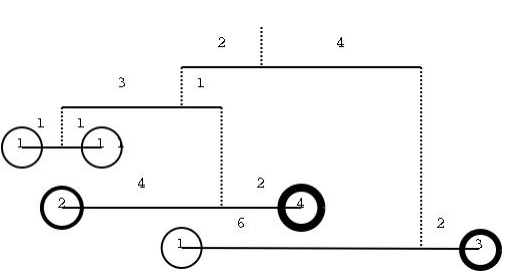uva-699 Not so Mobile (杠杆,巧妙递归)

| Not so Mobile |
Before being an ubiquous communications gadget, a mobile was just a structure made of strings and wires suspending colourfull things. This kind of mobile is usually found hanging over cradles of small babies.
The figure illustrates a simple mobile. It is just a wire, suspended by a string, with an object on each side. It can also be seen as a kind of lever with the fulcrum on the point where the string ties the wire. From the lever principle we know that to balance a simple mobile the product of the weight of the objects by their distance to the fulcrum must be equal. That isWl×Dl = Wr×Dr where Dl is the left distance, Dr is the right distance, Wl is the left weight and Wr is the right weight.
In a more complex mobile the object may be replaced by a sub-mobile, as shown in the next figure. In this case it is not so straightforward to check if the mobile is balanced so we need you to write a program that, given a description of a mobile as input, checks whether the mobile is in equilibrium or not.

Input
The input begins with a single positive integer on a line by itself indicating the number of the cases following, each of them as described below. This line is followed by a blank line, and there is also a blank line between two consecutive inputs.
The input is composed of several lines, each containing 4 integers separated by a single space. The 4 integers represent the distances of each object to the fulcrum and their weights, in the format: Wl Dl Wr Dr
If Wl or Wr is zero then there is a sub-mobile hanging from that end and the following lines define the the sub-mobile. In this case we compute the weight of the sub-mobile as the sum of weights of all its objects, disregarding the weight of the wires and strings. If both Wl and Wr are zero then the following lines define two sub-mobiles: first the left then the right one.
Output
For each test case, the output must follow the description below. The outputs of two consecutive cases will be separated by a blank line.
Write `YES' if the mobile is in equilibrium, write `NO' otherwise.
Sample Input
1 0 2 0 4
0 3 0 1
1 1 1 1
2 4 4 2
1 6 3 2
Sample Output
YES
题解:题意是让求这个杠杆是不是平衡;看了大神的代码,处理的很巧妙,如果当前质量是0,递归输入子天平,每个子天平判断是否平衡,就可以了;
代码:
#include<cstdio>
#include<cstring>
#include<cmath>
#include<algorithm>
#include<queue>
using namespace std;
#define SI(x) scanf("%d",&x)
#define mem(x,y) memset(x,y,sizeof(x))
#define PI(x) printf("%d",x)
#define P_ printf(" ")
const int INF=0x3f3f3f3f;
typedef long long LL;
bool solve(int &w){
int w1,d1,w2,d2;
scanf("%d%d%d%d",&w1,&d1,&w2,&d2);
int temp1=true,temp2=true;
if(!w1)temp1=solve(w1);
if(!w2)temp2=solve(w2);
w=w1+w2;
if(w1*d1==w2*d2&&temp1&&temp2)return true;
else return false;
}
int main(){
int T;
SI(T);
while(T--){
int w;
if(solve(w))puts("YES");
else puts("NO");
if(T)puts("");
}
return 0;
}
uva-699 Not so Mobile (杠杆,巧妙递归)的更多相关文章
- UVa 839 -- Not so Mobile(树的递归输入)
UVa 839 Not so Mobile(树的递归输入) 判断一个树状天平是否平衡,每个测试样例每行4个数 wl,dl,wr,dr,当wl*dl=wr*dr时,视为这个天平平衡,当wl或wr等于0是 ...
- UVa 699 The Falling Leaves(递归建树)
UVa 699 The Falling Leaves(递归建树) 假设一棵二叉树也会落叶 而且叶子只会垂直下落 每个节点保存的值为那个节点上的叶子数 求所有叶子全部下落后 地面从左到右每 ...
- UVA.839 Not so Mobile ( 二叉树 DFS)
UVA.839 Not so Mobile ( 二叉树 DFS) 题意分析 给出一份天平,判断天平是否平衡. 一开始使用的是保存每个节点,节点存储着两边的质量和距离,但是一直是Runtime erro ...
- UVA.699 The Falling Leaves (二叉树 思维题)
UVA.699 The Falling Leaves (二叉树 思维题) 题意分析 理解题意花了好半天,其实就是求建完树后再一条竖线上的所有节点的权值之和,如果按照普通的建树然后在计算的方法,是不方便 ...
- UVA 839 Not so Mobile (递归建立二叉树)
题目连接:http://acm.hust.edu.cn/vjudge/problem/19486 给你一个杠杆两端的物体的质量和力臂,如果质量为零,则下面是一个杠杆,判断是否所有杠杆平衡. 分析:递归 ...
- UVa 839 Not so Mobile (递归思想处理树)
Before being an ubiquous communications gadget, a mobilewas just a structure made of strings and wir ...
- 二叉树的递归遍历 The Falling Leaves UVa 699
题意:对于每一棵树,每一个结点都有它的水平位置,左子结点在根节点的水平位置-1,右子节点在根节点的位置+1,从左至右输出每个水平位置的节点之和 解题思路:由于上题所示的遍历方式如同二叉树的前序遍历,与 ...
- 【紫书】 The Falling Leaves UVA - 699 递归得简单
题意:给你一颗二叉树的前序遍历,空子树以-1表示,将左右子树的权值投影到一维数轴上,左儿子位置为根位置-1,右儿子+1求个个整点上的和: 题解:递归,整个过程只需维护一个sum数组. 更新根,更新le ...
- UVA 699 The Falling Leaves (递归先序建立二叉树)
题目链接:http://acm.hust.edu.cn/vjudge/problem/19244 #include <iostream> #include <cstdio> # ...
随机推荐
- HTML前端技术(JS的使用,包括数组和字符串)
<script type="text/javascript"> /* JS 数组的操作 //concat 连接两个或更多的数组,并返回结果. var arr1 = ne ...
- lua学习笔记1
lua中调用c的函数 #include <stdio.h> #include <string.h> #ifdef __cplusplus extern "C" ...
- (译) 《Javascript 24条最佳实践》
(摘录) <Javascript 24条最佳实践> 自己一直偏向于实用主义,不是学院派,不是学究派,只讲究把东西能够很好的做出来,但经过一段时间的开发工作当自己总结出来一些东西时,觉得挺有 ...
- ODI中删除数据的处理
ODI中删除数据的处理 一.前提知识:数据从源数据库向数据仓库抽取时,一般采用以下几种方式: 全抽取模式如果表的数据量较小,则可以采取全表抽取方式,以TRUNCATE/INSERT方式进行数据抽取. ...
- smtp cmd 测试 smtp发送邮件 cmd发送邮件
无账户MAIL FROM:<test@rmvbdy.com>RCPT TO:2850965781@qq.comDATASubject: test messagetest body . 有账 ...
- Oracle - index (索引)
索引: 一种独立于表的模式对象, 可以存储在与表不同的磁盘或表空间中 @ 索引被删除或损坏, 不会对表产生影响, 其影响的只是查询的速度 @ 索引一旦建立, Oracle 管理系统会对其进行自 ...
- 素数距离问题_ny_24.java
素数距离问题 时间限制: 3000 ms | 内存限制: 65535 KB 难度: 2 描述 现在给出你一些数,要求你写出一个程序,输出这些整数相邻最近的素数,并输出其相距长度.如果左右有等距 ...
- 性能优化工具---top
作用: 实时显示linux下各个进程的资源占用情况 参数: -d :后面可以接秒数,就是整个程序画面更新的秒数.预设是 5 秒: -p :指定某些个 PID 来进行观察监测而已. -b :以批次的方式 ...
- ZOJ 1563 Pearls(动态规划)
/* 分析: 因为他给的数据是递增的 而求得是这些数据总的 最优解 所以我们可以考虑,它的子问题求解不影响总的求解 也就是我们可以先求出 第一个的最优解 第二个....以此类推到总的最优解 那么我们想 ...
- java 笔试
单例设计模式: public class Singliton { //no new private Singliton (){ } static Singliton ins = null; publi ...
